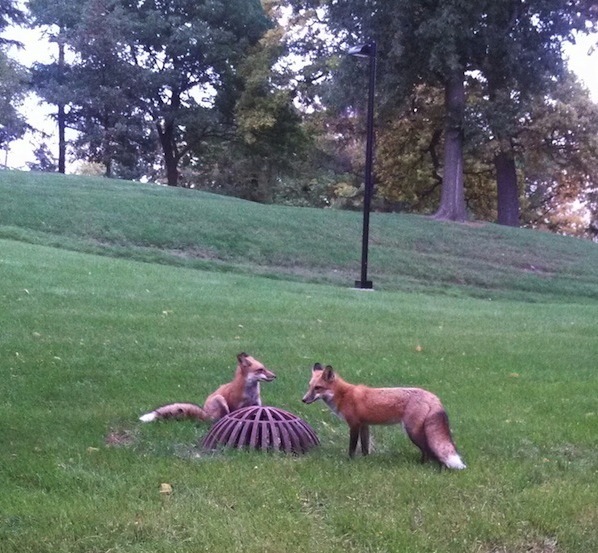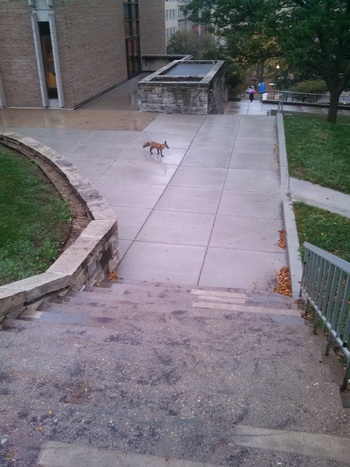Fox sightings a wild glimpse of nature on Observatory Hill

A pair of foxes inspect a drainage grate on Observatory Hill. A number of fox sightings have been reported recently in the vicinity of Nancy Nicholas Hall and Van Hise Hall.
Photos: David Giroux
There’s a story going around Nancy Nicholas Hall these days about a professor, teaching with his back to the building’s north-facing windows, who was interrupted mid-lecture.
“All at once, his students, who are facing the windows, are pulling out their cell phones and taking pictures, and he’s thinking, ‘What the heck is going on?” says Linda Zwicker, assistant dean for external relations and facilities in the School of Human Ecology. “And here is this little red fox walking along the wall behind our building.”
Fox sightings — in singles and pairs — have become regular news in the Observatory Hill neighborhood of campus since human ecology Dean Soyeon Shim posted to Twitter a photo of a fox on the last day of September.
David Giroux, UW System executive director, communications and external relations, has twice gotten close enough to snap photos of pairs of foxes on the lawns and walkways on the north side of Van Hise Hall, near the intersection of Charter Street and Observatory Drive.

This fox was recently spotted on a walkway outside of Van Hise Hall.
“They seemed quite comfortable in my presence,” Giroux says. “They didn’t want me to get too close, but they didn’t even bother to keep en eye on me until I was within maybe 10 feet.”
Doris Green, a human ecology university relations specialist, has had similar encounters, standing still while a good-sized fox pranced by.
“It pointedly ignored me, and passed by like I wasn’t even there,” says Green, who expects the fox has a den in the hillside north of Nancy Nicholas Hall.
The foxes have been spotted slinking past ground-floor Bascom Hall windows and picking their way through Allen Centennial Gardens. And that’s no surprise, according to Jonathan Pauli, a UW–Madison assistant professor of wildlife ecology.
“This urban or sub-urban environment, although dramatically different than these lakes were pre-settlement, are ecosystems unto themselves, and one foxes can definitely get along in,” Pauli says. “We have a complex predator guild here — hawks and coyotes and foxes — and this is probably a very good year for those predators.”
Trees that drop acorns and hickory nuts and other food — called “mast” — for rodents such as mice and chipmunks, had a banner year.
“It could be that we’re seeing foxes on campus because there are so many ground squirrels and mice and things that foxes prey on,” Pauli says.
“It’s good for humans to get the reminder that we’re not alone here. Even though we think of campus as a place for people, it’s obviously appealing to other species.”
Jonathan Pauli
And it’s fairly likely that the pair seen hanging out together are more than just friends. Foxes are monogamous, Pauli explained, and this is the time of year when mates — that’s one “dog” and one “vixen” — would be settling into a den.
“If they are paired up, and they’ve found a den, they will start breeding in a month or two,” Pauli says. “If they do have a litter, the parents will really be tied to that den, and I wouldn’t be shocked if in March or April, people begin to see pups out with their parents.”
It’s not a problem for the foxes to live so close to humans.
“It’s a wild animal, and unpredictable, so you shouldn’t try to pet them,” Pauli says. “But I don’t see anything wrong with it. If they get habituated, they will certainly get close to people. My guess is they’re eating a little bit of trash, but probably a lot of shrews and mice.”
In fact, Pauli thinks, people benefit from seeing them every once in a while.
“It’s good for humans to get the reminder that we’re not alone here,” he says. “Even though we think of campus as a place for people, it’s obviously appealing to other species. And we should be mindful of their presence.”



